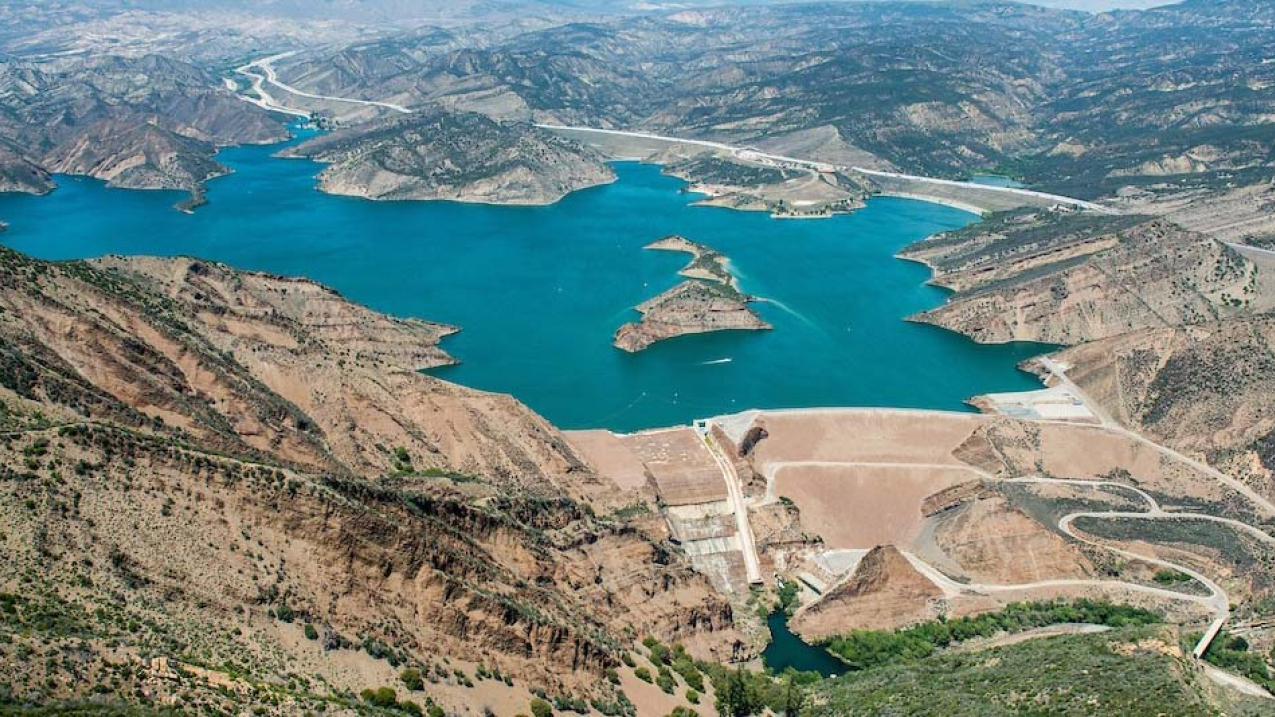
Pyramid Lake is a reservoir near Castaic, California. It stores water for delivery to Los Angeles and other coastal cities of Southern California. It also provides regulated storage for Castaic Powerplant and flood protection along Piru Creek which it dams. (Image credit: California Department of Water Resources)
In the Western United States, meeting water demands with available water supplies is becoming increasingly complex. Knowing where, when, and how much precipitation in a particular valley, mountain, lake, or river will become available for use to the people living there promotes efficiency as water managers will be able to more effectively prepare and meet the various water users’ needs and obligations.
To promote reliable access to water, last year President Trump issued a Presidential Memorandum on Promoting the Reliable Supply and Delivery of Water in the West. In that memo, the President directed the U.S. Department of Commerce (DOC) and the U.S. Department of the Interior (DOI) to develop an action plan, in coordination with water experts and resource managers, to improve forecasts of water availability. In response to the President’s directive, today, the DOC and the DOI are releasing the Federal Action Plan for Improving Forecasts of Water Availability (Action Plan).
"The Administration is committed to advancing America’s water infrastructure, and ensuring communities have reliable access to water," said Mary B. Neumayr, Chairman of the Council on Environmental Quality. "The Action Plan is an important step toward improving our Nation’s observation, modeling and forecasting capabilities related to water availability, enabling the Federal government and stakeholders to make more timely and informed decisions."
"The National Oceanic and Atmospheric Administration (NOAA) has met early milestones in the new federal action plan thanks to the landmark Weather Research and Forecasting Innovation Act and progress will continue to be made to improve water prediction forecasts through partnered activities leveraging the National Water Center," said RDML Tim Gallaudet, Ph.D., USN Ret., deputy NOAA administrator. "Over the next three years, we will enhance our modeling tools for connecting accurate precipitation forecasts into surface water availability forecasts."
"We are committed to using the best science available to reliably provide water and power for agriculture, municipal use and environmental needs," said Timothy R. Petty, Ph.D., Assistant Secretary for Water and Science, Department of the Interior. "Leveraging resources across the Federal family is the most effective way to utilize a modern water infrastructure through improved and expanded water forecasting tools."
The Action Plan identifies four areas for improvement: enhance weather forecasts to improve water prediction; improve and expand the use of water forecast information to benefit water management outcomes; improve science and technology for water prediction; and implement integrated water availability assessments at national and local basin scales.
Twelve activities in the Action Plan have been completed or are underway. In particular, NOAA ushered in its new global forecast model, the foundation for all its weather forecast models. This change paves the way for better numerical weather prediction into the future, including improved water prediction.
Another milestone was met when NOAA moved into operations version 2.0 of the National Water Model. This model simulates and forecasts how water moves throughout the nation’s rivers and streams using data from more than 8,000 U.S. Geological Survey (USGS) gauges to simulate conditions for over 5 million miles of rivers and streams in the contiguous United States. The model generates hourly forecasts for the entire river network as well as high-resolution forecasts of soil moisture, surface runoff, snow water equivalent, and other parameters. Version 2.1 of the National Water Model is scheduled for implementation in early 2021 and includes several enhancements to improve forecast accuracy.
NOAA also deployed the Hydrologic Ensemble Forecast Service (HEFS) in two new western river systems and three new river locations of reservoir inflow. The model delivers ensemble forecasts from 6 hours to a full year, which can be tailored to users' needs. The Bureau of Reclamation will develop and test methods using HEFS to inform reservoir operations decision making in these newly available systems.
The Bureau of Reclamation is also working with NOAA and the National Center for Atmospheric Research to improve short-term (5-day) forecasting in order to improve in-season reservoir operations for irrigation. Forecast Informed Reservoir Operations uses data from the watershed and weather and water forecasts to help water managers selectively retain or release water from reservoirs to balance operating priorities such as water supply, environmental flows, flood control, and dam safety. This approach is being tested at Lake Mendocino, California, a facility owned and operated by the U.S. Army Corps of Engineers.
The USGS continues to develop and refine the Next Generation Water Observation System, which will improve access to data that can be used in state-of-the-art forecasting and modeling tools to help improve decision-making by water managers. Additionally, the USGS will release the National Water Census at the end of calendar year 2019, which will provide daily national assessments of water availability, initially only in terms of quantity but inclusive of quality and use by the end of 2020.
While many activities to improve water forecasts are already underway, goals set in the Action Plan extend through 2023.
Media contact
Maureen O’Leary, NOAA Communications, 301-427-9000
Theresa Eisenman, Public Affairs, Bureau of Reclamation, 202-513-0574



